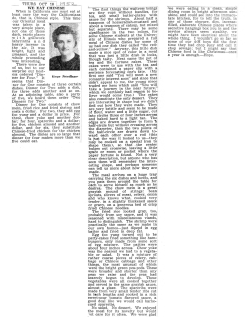When in California one must eat at least once the way the Californians do, that is, Chinese style. This time our Oriental meal was taken in a very simple place, not one of those dark, exotic places with grillwork labyrinths and heavy incense in the air. It was bright, light and pleasant, and the whole proceeding was interesting.
There were five of us, but to our surprise our hostess ordered "Dinner for Four." It seems that Dinner for One consists of three certain dishes, Dinner for Two adds a dish, for three adds another and so on. At an adjoining table, also a party of five, we heard them order "Two Dinners for Two."
Dinner for One consists of chow mein, fried rice and fried shrimp and costs a dollar. For two, they add egg foo yung and a dollar in price. For three, chow yoke and another dollar; for four, spareribs and a dollar; for five, chicken almond and another dollar, and for six, they substitute Chinese-fried chicken for the chicken almond. The dishes are so large that dinner for four makes more than we five could eat.
The first things the waitress brings are tiny cups without handles, for tea, and small butter-plates with sauce for the shrimps. About half a teaspoon of horseradish-mustard and about a teaspoon of catsup, not mixed but separate. There may be some significance in the two colors, for some Chinese students at the University of Illinois who prepared a full meal of Chinese dishes for some of us had one dish they called "the red-and-yellow." Anyway, this little dish made a nice spot of color in a meal that was just a little drab in looks, though tasty. Next came the pot of tea and the fortune cakes. These cakes were to use with the tea and each contained a paper slip with a sentence forecasting one's fate. (My first one said "You will meet a new romantic interest soon" and since that didn't appeal to me, the young niece traded me hers which said "You will take a journey in the near future," which we certainly had reason to believe would come true.) The cakes also constitute the only dessert. They are interesting in shape but we didn't find out how they were made. They are very brittle and seem to be made of flour, water and a little sugar, cut into circles three or four inches across and baked hard to a light tan. The edges are drawn together to form a half-circle but without creasing across the diameter, then the two points of the half-circle are drawn down toward each other over a rod (this is just the way it looked to us -- they may be cooked on a special iron to shape them), so that the center bulges out crosswise, leaving a little space or room or pocket where the paper fortune is found. Not a very clear description, but anyone who has seen them will remember the interesting shape, and perhaps someone can tell us more about how they are made.
The meal arrives on a huge tray carrying the six dishes and bowls, and you pass them around the table for each to serve himself as much as he desires. The chow mein is a great grayish mound of strings; bean sprouts, slivers of meat, celery, onion and who knows what, cooked very tender in a slightly thickened sauce or gravy, on a generous bed of crisp fried Chinese noodles.
The fried rice looked gray, too, probably from soy sauce, and it was seasoned with miscellaneous viands, hard to distinguish. The shrimp were practically the same as we make in our own homes -- just dipped in egg batter and fried in deep fat.
Egg foo yung turned out to be patty-cakes fried something like hamburgers, only made from some sort of egg mixture. The patties were about four inches across. Chow yoke was the nearest we had to a vegetable or salad. It was a mixture of rather coarse pieces of celery, cabbage or Chinese cabbage and other things, the most unusual of which were the bright green pea-pods. These were broader and shorter than any peas we raise and the peas had scarcely begun to develop. These vegetables were all cooked together and served in the same grayish sauce, almost a glaze. The spareribs were made from very small tender ribs cut in inch lengths and cooked in a rich sweet-sour tomato flavored sauce, a good deal like we would call barbecued spareribs.
No salad. No dessert. We enjoyed the meal for its novelty but would not care for it often. We were glad we were eating in a clean, simple dining room in bright afternoon sunshine, and could see into the immaculate kitchen, for to tell the truth, in one of those obscure, dim, incense-filled, elaborate Chinese places where secretive hangings box you in and the service always seem stealthy, we might have been skeptical about the whole thing. I wouldn't go so far as some of our 4-H boys did the first time they had chop suey and call it chop sewage; but I might say that Chinese food is like Christmas -- once a year is enough. -- Hope.

